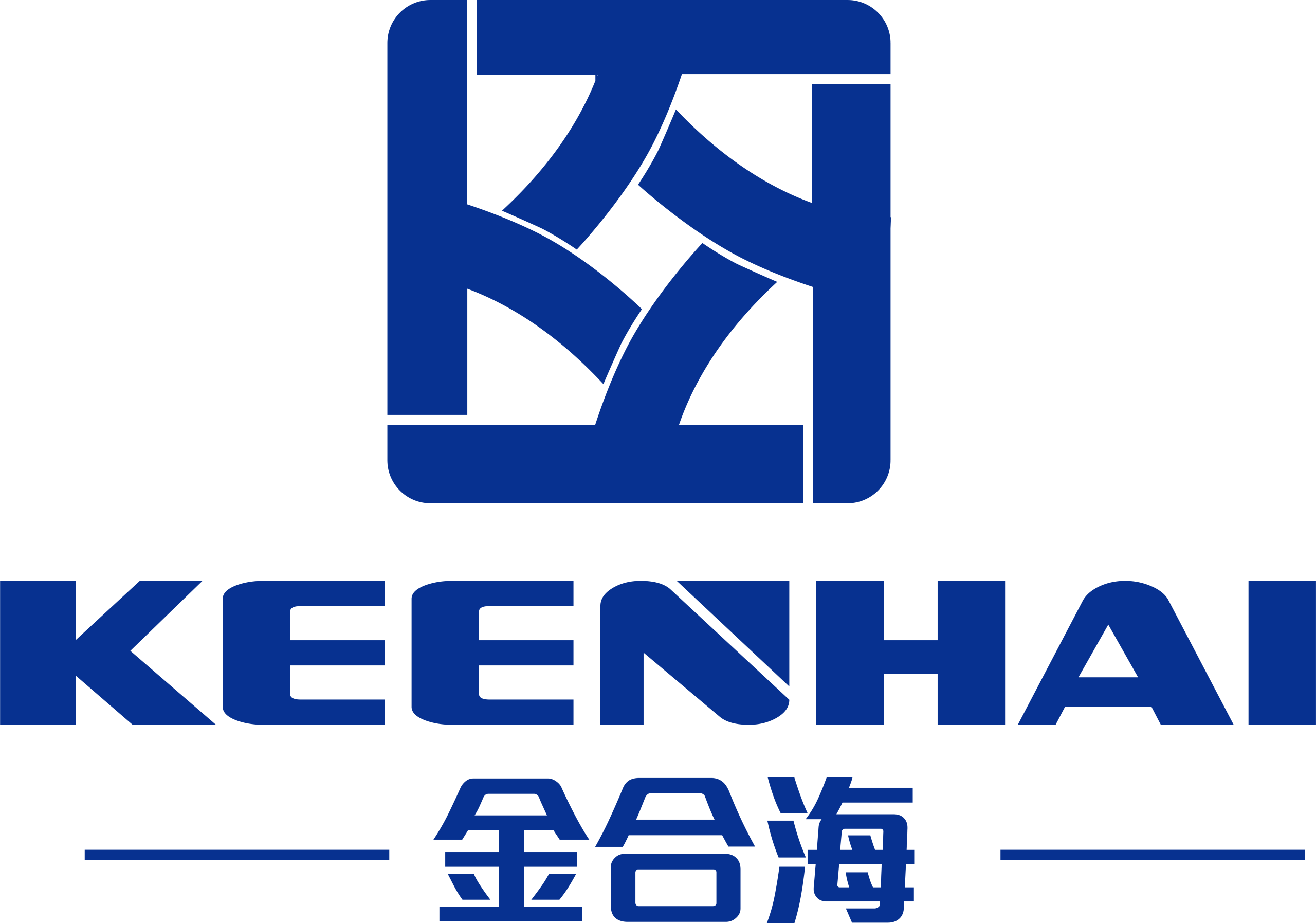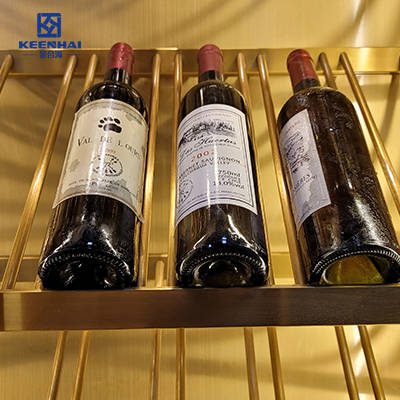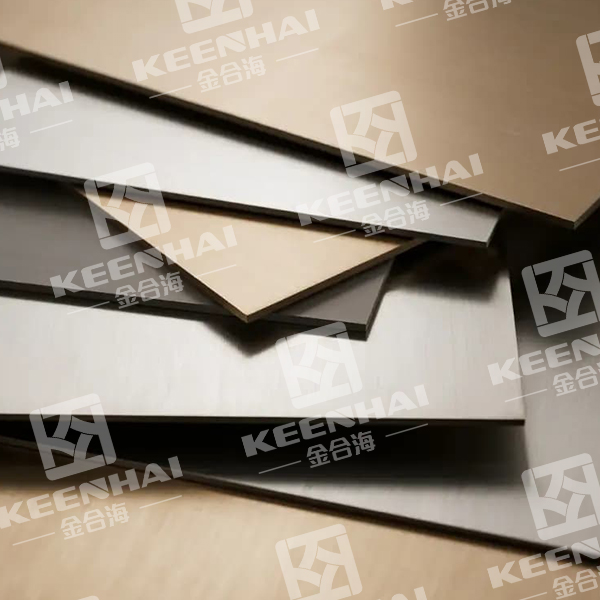PVD coating on stainless steel is a physical vapor deposition process that bonds a thin layer of metal, like titanium or zirconium, onto the surface. This creates durable, scratch-resistant, and corrosion-proof panels. It’s widely used in elevators, building facades, and decorative metal applications because it preserves the steel’s strength while offering vibrant, long-lasting colors.
What Does PVD Coating Mean for Stainless Steel
Physical Vapor Deposition Explained
Physical Vapor Deposition, often shortened as PVD, is a highly controlled vacuum-based process used to apply a decorative yet protective layer on hindi kinakalawang na asero. Unlike traditional painting or electroplating, this method relies on physics rather than chemistry. Engineers create a high-vacuum environment, sometimes reaching pressures as low as 10⁻³ to 10⁻⁵ Torr, to ensure the coating bonds at a molecular level.
The sequence of steps typically unfolds in a precise order:
-
Surface preparation – the base stainless sheet undergoes cleaning with alkaline solutions and ultrasonic baths to remove any microscopic oil, dirt, or oxide particles.
-
Loading into the vacuum chamber – the prepared sheets are arranged on rotating fixtures to guarantee uniform exposure during coating.
-
Evaporation or sputtering of the coating material – metals like titanium, zirconium, or chromium are vaporized using an electron beam or plasma discharge.
-
Condensation on the stainless surface – the vaporized particles travel in straight lines and condense onto the steel surface, forming a thin, dense, and uniform film.
-
Cooling and finishing – after deposition, the chamber cools down, and the coated stainless panels are polished to achieve the desired gloss or matte finish.
The resulting PVD layer usually measures between 0.2 to 5 microns in thickness. While this may sound microscopic, tests show that even at 0.5 microns, the hardness of the surface increases dramatically. For example, untreated stainless typically measures 150–200 HV on the Vickers hardness scale, whereas a PVD-coated surface can reach 1,000–2,000 HV, which is comparable to industrial-grade ceramics.
To highlight the technical differences, here’s a straightforward comparison:
| Property | Uncoated Stainless Steel | PVD-Coated Stainless Steel |
|---|---|---|
| Surface Hardness (HV) | 150–200 | 1,000–2,000 |
| Typical Coating Thickness | N/A | 0.2–5 microns |
| Color Range | Natural silver | Gold, bronze, black, blue |
| Corrosion Resistance (Salt Spray Test, hrs) | 200–400 hrs | 1,000+ hrs |
The physics behind PVD is what makes it distinct. Instead of forming a chemical compound like traditional coatings, the vaporized atoms physically embed themselves into the stainless substrate. This fusion creates a bond far stronger than paint or powder coatings. Scientists in surface engineering often refer to this as “atomic adhesion”, which explains why scratching or peeling rarely occurs under normal conditions.
The method has become a standard in industries where aesthetics must meet durability, such as architecture, consumer electronics, and even medical devices. For elevator applications, the precision of PVD ensures that large stainless steel sheets achieve both uniform color and a scratch-resistant surface, something no paint or lacquer can replicate at the same scale.
Why It Is Used on Stainless Steel
Stainless steel, while already highly durable and corrosion-resistant, still faces challenges in real-world applications. In coastal areas with salt-heavy air, uncoated 304 stainless can develop pitting corrosion within just a few years. When combined with PVD, the surface gains an additional barrier that significantly reduces this risk. Independent salt spray tests show that uncoated 304 steel withstands about 400 hours, whereas PVD-coated panels endure over 1,000 hours without visible damage.
The advantages extend beyond durability. PVD allows architects and designers to choose from a wide variety of colors without compromising the natural strength of the steel. Options range from brass-like gold finishes to deep graphite tones, which stay stable for decades because the color comes from the deposited metal ions, not from pigments or dyes.
Another reason PVD has become indispensable in custom stainless steel elevator doors is hygiene. The ultra-smooth coating reduces the microscopic pores on the steel surface, making it harder for bacteria to cling. This characteristic has been tested in public facilities such as airports, where daily contact can exceed 2,000 touches per panel. Surfaces treated with PVD showed 35% lower bacterial adhesion compared to untreated stainless.
The application also addresses cost-effectiveness. While the upfront price of PVD stainless steel panels is higher than standard brushed steel, the reduced maintenance costs offset the difference. Traditional painted or laminated elevator doors need refinishing every 5–7 years, whereas PVD panels often last 20 years or more without losing color or shine. Building managers often consider this a long-term investment rather than a recurring expense.
To illustrate, let’s compare common alloys used with and without PVD:
| Stainless Steel Grade | Uncoated Performance | With PVD Coating |
|---|---|---|
| 304 (general purpose) | Good corrosion resistance, prone to pitting in salty air | Enhanced corrosion resistance, color stability, 2x hardness |
| 316 (marine grade) | Excellent corrosion resistance, higher cost | Maximum protection, extended aesthetic variety, cost justified for luxury use |
For metal cladding projects on facades or stainless steel exterior walls, PVD also proves valuable. Large-scale installations in high-rise buildings often use bronze or champagne-colored coatings that stay consistent across hundreds of square meters. This uniformity cannot be achieved with paint, where fading and patchiness are common after just a few years.
Ultimately, PVD provides a balance of strength, appearance, and longevity. From modern architectural finishes to interior details like wine cellars, the technology transforms stainless into a material that adapts to both practical and design-focused needs.
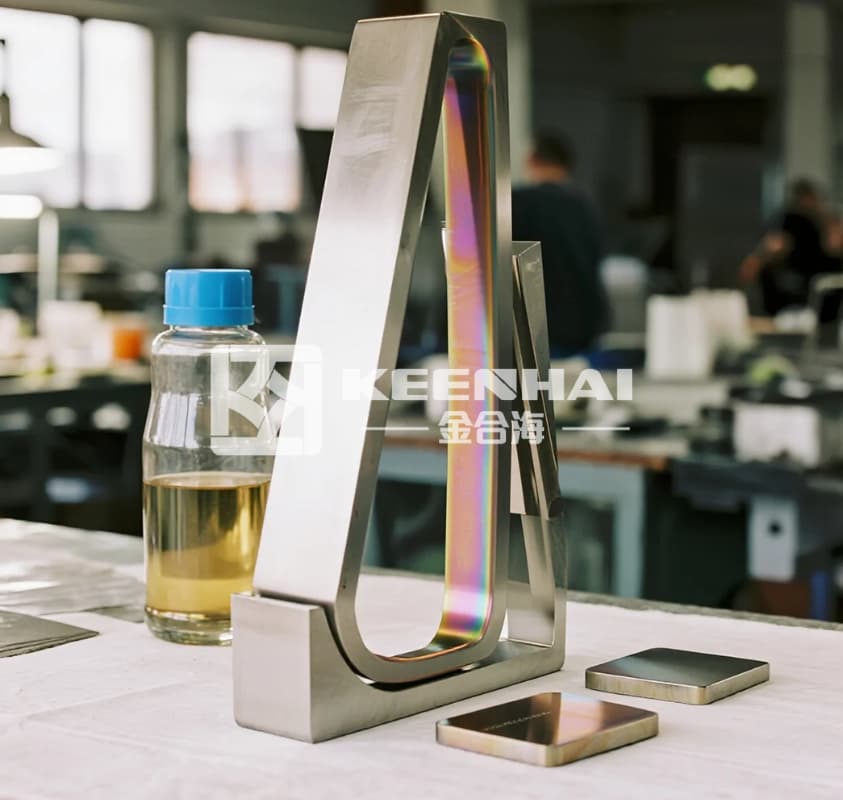
Core Materials Used in PVD Stainless Steel
304 vs 316 Stainless Steel Base Grades
When we talk about PVD stainless steel elevator door panels, the base grade matters just as much as the surface finish. The two most common choices are 304 stainless steel at 316 hindi kinakalawang na asero, and while they belong to the same family, their performance differs in real-world projects.
304 stainless steel works brilliantly for indoor spaces—corporate towers, residential lobbies, or retail complexes. It contains about 18% chromium and 8% nickel, which gives it reliable corrosion resistance for environments that don’t face heavy salt or chemical exposure. Many stainless steel products in elevators and cladding use 304 because it balances cost and durability. For example, a premium office building in Singapore installed custom stainless steel elevator doors with a bronze PVD finish back in 2015. After 7 years, the panels still look polished, requiring nothing more than routine cleaning.
316 hindi kinakalawang na asero, often called “marine grade,” takes things a step further. It adds 2–3% molybdenum to the standard chromium-nickel mix, giving it stronger resistance to salt air and harsh chemicals. A luxury beachfront hotel in Miami opted for 316 PVD elevator panels in its main lobby, and after a decade facing ocean humidity, they show zero pitting or discoloration. In contrast, a neighboring property that used 304 sheets had visible corrosion within just three years.
| Property | 304 Stainless Steel | 316 Stainless Steel |
|---|---|---|
| Nickel Content | ~8% | ~10–12% |
| Molybdenum | None | 2–3% |
| Best Use | Indoor, controlled environments | Coastal, humid, or chemical-prone areas |
| Kahabaan ng buhay | 7–10 years indoors | 10–15 years outdoors or high-moisture areas |
In short, 304 is perfect for commercial towers and residential high-rises, but for coastal hotels, subways, or luxury spas, 316 hindi kinakalawang na asero is the smarter investment.
Thickness and Surface Preparation
The thickness of a stainless steel sheet and the way it’s prepared before PVD coating directly determine how long it will perform. If the sheet is too thin or the surface is not properly finished, the coating won’t hold, no matter how advanced it is.
For elevator doors, typical thickness ranges from 0.8 mm to 2.0 mm. In standard office towers, architects often specify 1.0–1.2 mm, which provides a balance between durability and cost. But in metro stations or airports, panels need to go up to 2.5 mm to withstand constant impact from luggage, strollers, and heavy passenger traffic. Walk through the Tokyo Metro and you’ll see brushed 2.5 mm panels still looking intact after years of service.
Surface preparation involves several key steps:
-
Cleaning the raw panel – All oils, grease, and dust must be fully removed. Even micro-residues weaken adhesion.
-
Mechanical finishing – Surfaces are polished or brushed depending on design goals. A five-star hotel in Dubai chose mirror-polished gold PVD for its lobby elevators to reflect marble interiors, while a Shanghai subway station went with brushed black panels to minimize visible scratches.
-
Vacuum conditioning – The sheet enters a vacuum chamber where remaining particles are stripped away and the surface gets activated for stronger bonding.
-
PVD application – Only after the base meets all requirements does the vapor deposition process take place, locking the color and texture into the steel.
| Location | Panel Thickness | Finish | Performance Expectation |
|---|---|---|---|
| Office Tower Elevators | 1.0–1.2 mm | Brushed / Hairline | 8–10 years with minimal care |
| Metro Stations | 2.0–2.5 mm | Brushed | High impact resistance, 10+ years |
| Luxury Hotels | 1.2–1.5 mm | Mirror Polish | Premium aesthetics, 10+ years lifespan |
Designers working on metal cladding for a stainless steel exterior wall often demand thicker bases to prevent dents, especially in high-traffic zones. Meanwhile, custom wine storage rooms or luxury lounges may prefer thinner yet mirror-polished panels for aesthetic appeal, similar to a stainless steel wine cellar installation in Hong Kong that blends function with prestige.
The takeaway: the right thickness and surface preparation aren’t just technical details—they decide whether your PVD-coated panels age gracefully or fail under daily pressure.
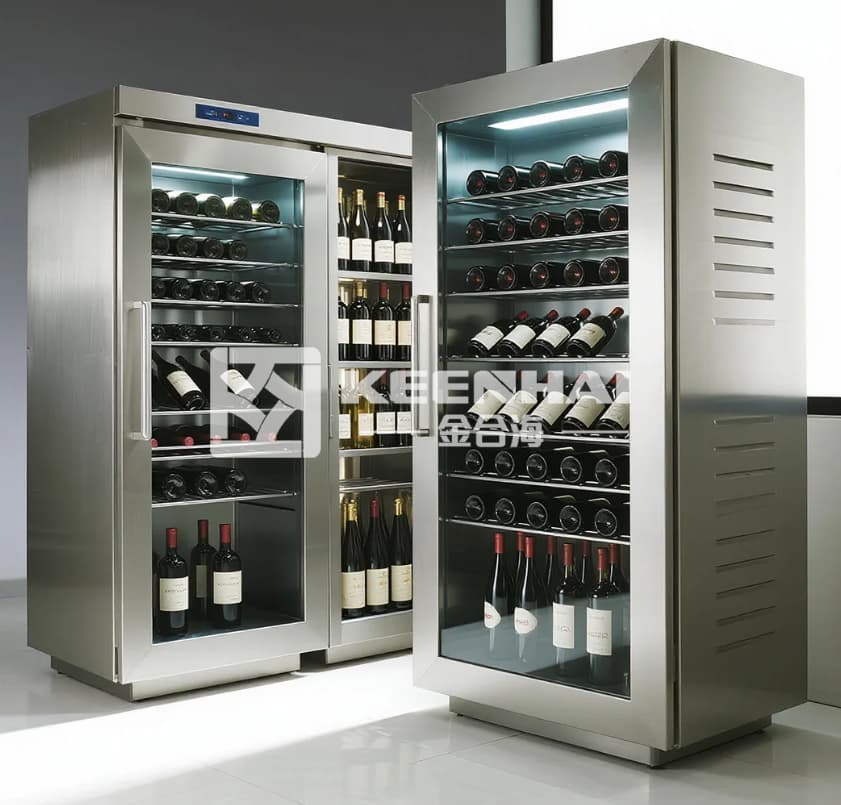
PVD Coating Process in Stainless Steel
Vacuum Chamber and Temperature Control
The PVD stainless steel process starts inside a vacuum chamber, which is essential for ensuring a clean, controlled environment. Pressure inside drops to 0.01 Pa, almost a million times lower than normal atmospheric pressure, removing contaminants like oxygen and dust.
Temperature is just as critical. Most stainless steel sheets heat to 400–500°C, softening the surface to accept the metallic coating. For example, a luxury hotel in Dubai installed PVD-treated elevator doors to prevent fingerprints and humidity damage. Operators maintained chamber temperatures within a ±5°C range; even a minor fluctuation can cause uneven color bands.
High-traffic locations like the Hong Kong MTR demand panels that resist scratches and cleaning chemicals. With proper vacuum and temperature control, PVD coatings bond at an atomic level, lasting over a decade.
Deposition of Metallic Compounds
After preparation, the process moves to metallic compound deposition. Titanium, zirconium, or chromium compounds vaporize and travel as plasma under vacuum until they bond with the produktong hindi kinakalawang na asero surface.
Take the Macau hotel gold mirror-finish elevator doors: titanium nitride (TiN) vapor fused into the steel at around 450°C, creating a hardness above 2,000 HV, far tougher than the base metal. The result: panels survive scratches from luggage and high traffic without dulling.
The process involves four steps:
-
Target selection – Choose metallic compound (TiN, ZrN, CrN).
-
Ionization – Plasma generation through high voltage.
-
Transport under vacuum – Plasma evenly coats the surface.
-
Bonding – Fusion into steel lattice, forming a permanent finish.
A practical case: Beijing Capital Airport Terminal 3 used zirconium-based PVD coatings on hindi kinakalawang na asero panlabas na pader panels for elevators and escalators. The coating withstands heavy cleaning and luggage impact, lasting over 12 years with minimal wear.

Key Benefits of PVD Coating Stainless Steel
Scratch and Corrosion Resistance
One of the biggest selling points for PVD stainless steel is scratch and corrosion resistance. When titanium or zirconium compounds bond to a stainless steel sheet, the surface reaches a hardness of 2,000–2,500 HV, which is multiple times tougher than untreated stainless steel. For high-traffic areas like airport elevator doors or office building lobbies, this means daily abrasions from suitcases, carts, or heels leave almost no visible marks.
Corrosion resistance is equally impressive. PVD coatings form a barrier that prevents oxidation even in humid or chemical-cleaned environments. For instance, Macau luxury hotels use PVD-coated elevator panels in coastal locations, where salt-laden air would quickly dull conventional stainless steel. These panels maintain their finish for over 10–15 years with minimal maintenance.
Aesthetic Variety and Longevity
Another standout benefit of PVD-coated stainless steel products is the aesthetic variety. You can achieve colors from gold, bronze, rose copper to deep black without painting or laminates. In high-end projects like five-star hotel elevators in Dubai or luxury condominium lobbies in Singapore, designers often specify PVD for its modern, mirror-like finishes. These surfaces don’t fade, peel, or discolor, unlike traditional coatings.
The process also extends the lifespan of stainless steel surfaces. With PVD, a standard 2.0 mm elevator door panel can maintain its appearance for 12–15 years in commercial settings, compared to 5–7 years for brushed stainless steel. Regular cleaning involves mild detergents and soft cloths, making upkeep simple and cost-effective.
Practical cases: Beijing Capital Airport Terminal 3 implemented PVD-coated hindi kinakalawang na asero panlabas na pader panels for elevators and escalators. After over a decade, the panels still look pristine, even with thousands of daily passengers and constant chemical cleaning.
For more detailed insights on the applications and benefits of PVD stainless steel sheets, visit our comprehensive guide: What is a PVD Stainless Steel Sheet?
